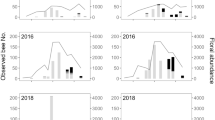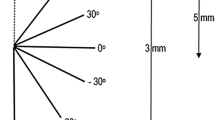Summary
The rates at which bumblebees of different proboscis lengths forage on flowers of a series of corolla tube lengths were determined. The results indicate significant correlations between proboscis length and time spent by bees on flowers. Bumblebees of long proboscis length can forage significantly faster than bees of shorter proboscis length on flowers with long corolla tubes. There is also evidence which suggests that bumblebees of short proboscis length prefer and are more efficient on short corolla tubes. These results support the use of proboscis length as a morphological indicator of resource utilization in bumblebees.
Similar content being viewed by others
References
Abbott, I., Abbott, L.K., Grant P.R.: Seed selection and handling ability of four species of Darwin's Finches. Condor 77, 332–335 (1975)
Benedek, P.: Relationship between the tripping rate and the tongue length of lucerne pollinating wild bees. Z. ang. Ent. 73, 113–116 (1973)
Brian, A.D.: The foraging of bumble bees I. Foraging behavior. Bee World 35, 61–67 (1954)
Cumber, R.A.: The biology of bumble-bees, with special reference to the production of the worker caste. Trans. Roy. Entomol. Soc. London 100, 1–45 (1949)
Dennis, B.A., Haas, H.: Pollination and seed-setting in Diploid and Tetraploid Red Clover under Danish conditions. I. Seed-setting in relation to the number and type of pollinating insects. Royal Veterinary and Agricultural College, Yearbook: 93–117 (1967)
Dennis, B.A., Haas, H.: Pollination and seed-setting in Diploid and Tetraploid Red Clover under Danish Conditions. II. Studies of floret morphology in relation to the working speed of honey and bumble-bees. Royal Veterinary and Agricultural College, Yearbook: 118–133 (1967)
Friden, F., Eskillson, L., Bingefors, S.: Bumblebees and red clover pollination in central Sweden. Sveriges Froodl. Forb. medd. 7, 17–26 (1962)
Hainsworth, F.R.: On the tongue of a hummingbird: its role in the rate and energetics of feeding. Comp. Biochem. Physiol. 46A, 65–78 (1973)
Hawkins, R.P.: Length of tongue in honey bee in relation to the pollination of red clover. J. Agric. Sci., Camb. 73, 489–493 (1969)
Hespenheide, H.A.: The selection of seed size by finches. Wilson Bull. 78, 191–197 (1966)
Hespenheide, H.A.: Ecological inferences from morphological data. Ann. Rev. Ecol. Syst. 4, 213–229 (1973)
Hobbs, G.A.: Further studies on the food-gathering behavior of bumblebees. Can. Ent. 19, 538–541 (1962)
Hobbs, G.A., Nummi, W.O., Virostek, J.F.: Food-gathering behavior of honey, bumble, and leaf-cutter bees in Alberta. Can. Ent. 93, 409–419 (1961)
Holm, S.N.: The utilization and management of bumble bees for red clover and alfalfa seed production. Ann. Rev. Ent. 11, 55–182 (1966)
Inouye, D.W.: Resource partitioning and community structure: A study of bumblebees in the Colorado Rocky Mountains. Ph. D. Disseration. Univ. of N.C., Chapel Hill (1976)
Inouye, D.W.: Species structure of bumble bee communities in North America and Europe. In: The role of arthropods in forest ecosystems. (W.J. Mattson, ed.), pp. 35–49. Berlin Heidelberg New York: Springer-Verlag 1977
Inouye, D.W.: Patterns of corolla tube length of bumble bee flowers from two continents. Proc. 4th Int. Symposium on Pollination. Md. Agric. Exp. Sta. Spec. Misc. Publ. 1, 461–463 (1979)
Knuth, P.: Handbook of flower pollination. Oxford: University Press (1906–1909)
Kugler, H.: Die Bestaubung von Blumen durch Furchenbienen (Halictus Latr.). Planta 30, 780–799 (1940)
Lovell, J.H.: The flower and the bee. New York: Charles Scribner's Sons (1918)
Macior, L.W.: Pollination ecology of the front range of the Colorado Rocky Mountains. Melanderia 15, (1974)
Macior, L.W.: Pollination ecology of vernal angiosperms. Oikos 30, 452–460 (1978)
Medler, J.T.: Morphometric analyses of bumblebee mouthparts. Verhandl. XI. Internat. Kongr. Entomol. Wien 1960. 3, 517–521 (1962)
Medler, J.T.: Morphometric studies on bumble bees. Ann. Ent. Soc. Amer. 55, 212–218 (1962)
Morse, D.H.: Estimating proboscis length from wing length in bumblebees (Bombus spp.). Ann. Ent. Soc. Amer. 70, 311–315 (1977)
Pisani, J.F., Sakagami, S.H.F., Crestana, B., Aily, D., Lorenzetti, M.L.: Multivariate statistical analysis applied to a morphometric study on bumblebeees. An. Acad. Brasil. Cienc. 40, 373–389 (1968)
Poulsen, M.H.: The frequency and foraging behavior of honeybees and bumblebees on field beans in Denmark. J. Apic. Res. 12, 75–80 (1973)
Root, R.B.: The niche exploitation pattern of the blue-grey gnatcatcher. Ecol. Monogr. 37, 317–350 (1967)
Schemske, D.W.: Pollinator specificity in Lantana camara and L. trifolia Verbenaceae. Biotropica 8, 260–264 (1976)
Snodgrass, R.E.: Anatomy of the honey bee. Ithaca, New York: Comstock Publishing Associates (1956)
Stapel, C.: Undersøgelser over Humlebier (Bombus Latr.), deres Udbredelse, Traekplanter og Betydning for Bestovningen af Rødkløver (Trifolium pratense L.). Tidsskr. Planteavl. 39, 193–294 (1933)
Stiles, F.G.: Ecology, flowering phenology, and hummingbird pollination of some Costa Rican Heliconia species. Ecology 56, 285–301 (1975)
Teräs, I.: Flowering visits of bumblebees, Bombus Latr. (Hymenoptera: Apidae), during one summer. Ann. Zool. Fennici 13, 200–232 (1976)
Valle, O.: Pollination and seed setting in tetraploid red clover in Finland. Acta Agralia Fennica 95, 1–35 (1959)
Valle, O., Salminen, M., Huokuna, E.: Pollination and seed setting in tetraploid red clover in Finland II. Acta Agralia Fennica 97, 1–63 (1960)
Willson, M.F.: Seed selection in some North American finches. Condor 73, 419–429 (1971)
Willson, M.F.: Seed-size preferences in finches. Wilson Bull. 84, 449–455 (1972)
Wojtowski, F.: Use of the wildbees of the genus Anthophora and Bombus for papilionaceous seed plants pollination. Roczniki Wyzszej Szkoly Rolniczej no Poznaniu 24, 223–274 (1965)
Author information
Authors and Affiliations
Rights and permissions
About this article
Cite this article
Inouye, D.W. The effect of proboscis and corolla tube lengths on patterns and rates of flower visitation by bumblebees. Oecologia 45, 197–201 (1980). https://doi.org/10.1007/BF00346460
Received:
Issue Date:
DOI: https://doi.org/10.1007/BF00346460




